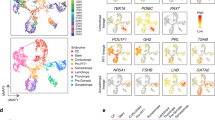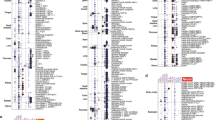Abstract
THE Myxinoids are possibly the most primitive living vertebrates, and the pituitary of Myxine glutinosa has hitherto1–3 been described as having a separate infundibulum and adenohypophysis, a condition which has been regarded as primitive or degenerate. Furthermore, the adenohypophysis which lies embedded as groups of cells in connective tissue, has been described as being composed solely of chromophobes, and having no cytological or histological differentiation. Recent observations, however, have shown that the connective tissue septum does not separate completely the two parts of the pituitary but that the posterior end of the infundibulum comes into intimate contact with the adenohypophysis (Fig. 1). Also, the adenohypophysis is cytologically differentiated.
This is a preview of subscription content, access via your institution
Access options
Subscribe to this journal
Receive 51 print issues and online access
$199.00 per year
only $3.90 per issue
Buy this article
- Purchase on Springer Link
- Instant access to full article PDF
Prices may be subject to local taxes which are calculated during checkout
Similar content being viewed by others
References
De Beer, G. R., “The Comparative Anatomy, Histology and Development of the Pituitary Body” (Oliver and Boyd, London, 1926).
Grasse, P. P., “Traité de Zoologie”, 13 (Masson, Paris, 1958).
Stendall, W., Arch, mikrosk. Anat., 82, 289 (1913).
Author information
Authors and Affiliations
Rights and permissions
About this article
Cite this article
MATTY, A. The Pituitary of Myxine glutinosa . Nature 185, 180–181 (1960). https://doi.org/10.1038/185180b0
Issue Date:
DOI: https://doi.org/10.1038/185180b0
This article is cited by
-
The ultrastructure of the adenohypophysis of Myxine glutinosa
Zeitschrift f�r Zellforschung und Mikroskopische Anatomie (1972)
-
Zur Histologie der Hypophyse des Flussneunauges (Lampetra fluviatilis L.)
Zeitschrift f�r Zellforschung und Mikroskopische Anatomie (1966)
-
Hypophysectomy and Blood Sugar Regulation in a Cyclostome, Myxine glutinosa
Nature (1965)
-
Cytology of the myxine adenohypophysis
Die Naturwissenschaften (1965)
-
Antidiuretische Wirkung von Hypophysen-Hypothalamusextrakten vonMyxine glutinosa L. (Cyclostomata)
Die Naturwissenschaften (1961)
Comments
By submitting a comment you agree to abide by our Terms and Community Guidelines. If you find something abusive or that does not comply with our terms or guidelines please flag it as inappropriate.



